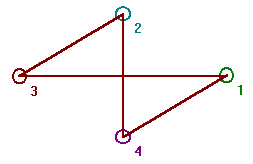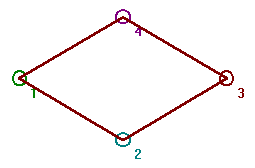 Graph Theory Lessons
Graph Theory Lessons



 Lesson
3: Isomorphism
Lesson
3: Isomorphism

Let G1 and G1
be two graphs and let f be a function from the vertex set of G1
to the vertex set of G2. Suppose that
-
f is one-to-one and onto
-
f(v) is
adjacent
to f(w) in G2 if and only if v is adjacent
to w in G1.
Then we say that the function f is an isomorphism
and that the two graphs G1 and G2
are isomorphic. So two graphs G1
and G2 are isomorphic if there is a one-to-one correspondence
between vertices of G1 and those of G2
with the property that if two vertices of G1 are adjacent
then so are their images in G2. If two graphs are isomorphic
then as far as we are concerned they are the same graph though the location
of the vertices may be different. To show you how the program can be used
to explore isomorphism draw the graph in figure 4 with the program (first
get the null graph on four vertices and then use the right mouse to add
edges).

|
|
Fig. 4
|
Save this graph as Graph 1 (you need to click
Graph then Save). Now get the circuit graph with 4 vertices.
It looks like figure 5, and we shall call it C(4).

|
|
Fig. 5
|
Click Relations and Isomorphism.
You will get a new window with two picture boxes. Click on the Start
button. You will get a list of the graphs currently saved. Click on Graph
1. Now the text box should say that Graph 1 and C(4) are isomorphic. Click
on Morph. You will get some animation. The graph on the left will
deform until it looks like the one on the right. Actually as far as we
are concerned they are the same graph. The reason the vertices of the right
graph are labeled using letters of the alphabet is so you can talk about
them without having duplication of names. In the textbox you will get the
relation that connects vertices of one graph to those of the other. If
you want to see the animation again click Redo. On these small graphs
it only takes a short time to find an isomorphism but on larger graphs
it takes much longer. We will discuss this in class in more detail.
When two graphs are isomorphic we consider them to be the same graph. The
applet below shows several depictions of the same graph. We shall call it
the cube since in one of the depictions it looks like a cube.
Some depictions of the Cube.
When a graph can be drawn without any of the edges
crossing we say that it is a planar graph . Fig. 4 and Fig. 5 are the same
graph drawn in different ways. Fig. 5 is a plane depiction of it. Of course,
not all graphs are planar. To check if a graph's depiction is planar you can click Properties,
Planar Graphs, and then Plane?.
-
Draw all the (non-isomorphic) simple graphs on four
vertices.
-
Let us define a relation R on graphs by G1R
G2 if G1 is isomorphic to G2.
-
Is R reflexive?
-
Is R symmetric?
-
Is R transitive?
-
Is R an equivalence relation?
 e-mail: C.
Mawata
e-mail: C.
Mawata



 © C. Mawata
© C. Mawata


 Lesson
3: Isomorphism
Lesson
3: Isomorphism

